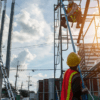Australia’s population is set to reach 40 million by 2059, and the Australian government has taken on a multitude of infrastructure projects to support the needs of this growing population. From advanced communications and future cities to improved critical water infrastructure and supply chain infrastructure.
Some of the highest-valued infrastructure projects that are currently ongoing in Australia bear witness to this development.
WestConnex, located in New South Wales, is a 33-kilometre, light-free highway network valued at $16 billion. The third stage of the project, a $3.2 billion underground tunnel connecting two motorways (the M4 and the M8) opened to the public earlier this year.
Sydney Metro, also located in NSW, is Australia’s largest public transportation project, valued at $12 billion.
Melbourne Metro Tunnel in Victoria is a new end-to-end train line connecting Sunbury and Cranbourne. It is valued at $11 billion.
As the focus on these projects continues to heighten, the risks associated with the projects also evolve and grow—presenting new challenges for risk management in infrastructure projects. Understanding the risk landscape for infrastructure projects is vital to establishing effective mitigation strategies.
What are the most prominent risks for infrastructure projects?
The most common risks associated with infrastructure projects in Australia are as follows.
Political risks
Political risks like changes in government policies, regulations, or laws can impede project timelines, budget, and feasibility.
Australia will hold its next federal election during or before 2025. If this results in a significant change and the new government cancels or delays ongoing projects, it can cause significant losses for investors, contractors, and other stakeholders involved in the project.
Changes in zoning laws or environmental regulations could impact project design and construction, resulting in delays or additional costs. Regulation changes are plausible with the Australian government’s commitment to climate control policies.
Political instability or conflict could also cause interference with infrastructure projects by discouraging potential investors and impeding operations.
Political risks are a serious consideration as they have the potential to result in severe outcomes like project cancellation or abandonment. This can result in significant losses for all parties involved. Thus, having the appropriate mitigation strategies for risk management in infrastructure projects is vital.
Financial risks
As infrastructure projects are often large-scale and require significant financial investment, financial risks can put investors and contractors at risk. They can be exposed to risks like budget overruns, delays, and other unexpected expenses.
If a designated project is not completed within a set timeframe and budget, it can result in significant financial losses for investors and contractors.
Fluctuations in the economy and financial markets can cause changes in interest rates, exchange rates, and the inflation rate. These can have a knock-on effect on infrastructure project financing and profitability.
Financial risks have the potential to cause project cancellations or abandonment, resulting in significant financial losses for investors and contracts. Therefore, effective forms of financial risk management in infrastructure projects must be in place to ensure success.
Labour risks
Infrastructure projects often employ a diverse and large number of employees and risks like labour shortages, strikes, or disputes between workers and management are likely to impact them.
Labour shortages can cause delays or quality issues in infrastructure projects, which can have both short and long-term impacts on Australia’s infrastructure system.
Similarly, strikes or disputes within the workforce can cause work stoppages and disruptions in the work schedule, affecting project delivery.
Labour risks can also be the result of safety hazards or accidents in the workplace, which can cause injuries or fatalities for employees and disrupt operations, affecting the project timeline and budget.
Labour risks can not only cause delays or cancellations in projects but also cause regulatory compliance issues that may result in legal complications as well. Therefore, maintaining management practices for labour-related risks is important when managing infrastructure projects.
Contractual risks
Contractual risks may arise as a result of the myriad of parties that are involved in infrastructure projects including contractors, subcontractors, suppliers, and clients failing to meet their contractual obligations. These can range from breaches of contract and contract disputes to changes in contract terms.
Contract disputes can cause interruptions in the project workflow and impact project timelines.
Breaches in contracts may necessitate contract terminations, significantly impacting budget and project timelines.
Inadequate contract management and poor communication can also cause contractual risks, leading to misunderstandings and disputes that affect project progress.
Contractual risks are a highly important consideration that must be managed with adequate strategies for effective risk management in infrastructure projects.
Establish a solid framework for risk management in infrastructure projects in Australia
The risk landscape for infrastructure projects is extensive, and managing these risks effectively is paramount for successful project completion.
Digital risk management tools that can cater to critical infrastructure risk management offer a wealth of functionality for effective risk management for infrastructure projects, enhancing risk resilience and ensuring project success.






